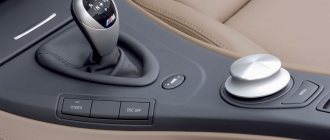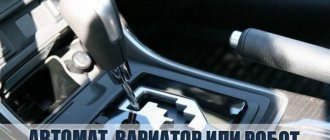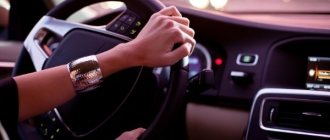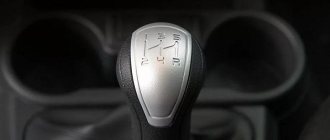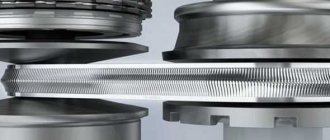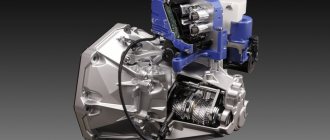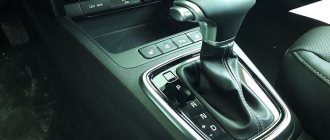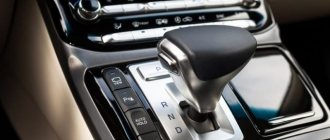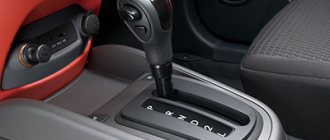There are 4 types of gearboxes (gearboxes). The share of cars with a robotic gearbox, classic automatic and CVT on the roads is constantly growing, because more and more motorists are abandoning manual mechanics. Transmissions that operate without human intervention are constantly being improved. Their quality, speed of reaction to road events, smoothness of actions become better, and any trip is more comfortable.
It is much more convenient with a robotic gearbox.
What is a robotic gearbox
A robotic gearbox (RMG, or robot) is part of a vehicle’s transmission. Sometimes it is confused with an automatic transmission, but they are different from each other. Manual transmission consists of a manual transmission, automatic switches of electric or hydraulic type (actuators) and a control unit for these switches (ECU). That is, the box itself is mechanical; only the control of its operation is automatic.
For the driver, the manual transmission looks almost like an automatic transmission. There is no gearshift lever at hand (on some models there is a selector knob instead), and there are no clutch pedals underfoot. While driving, gears are switched automatically.
Comparison of two gearboxes: what is the difference between a robot and an automatic machine
This block summarizes the comparative results of the topic: “Which gearbox is better, automatic or robot?”
The table below shows the differences between robot and automatic gearboxes.
| Type of differences | Robot | Machine |
| Constructive | Mechanical box with electronic control unit | Torque converter, planetary gearbox, valve body |
| Functional | Availability of manual switching function | Manual switching |
| Price | Darling in TO | Low cost service |
| Consumer | Low consumption of fuels and lubricants | Large amounts of oil and fuel consumption |
Now it will be easier for a novice car owner to choose between these two types of automatic transmission. The next block provides some advice from experienced car owners and mechanics on choosing one or another device if the car enthusiast has already taken a step towards one of the types.
Read
What is the difference between a CVT and an automatic: how to find out and which is more reliable
How it works
The manual transmission, equipped with a clutch disc connected to the engine flywheel, is controlled by a robot. The algorithm incorporated by the developers into the ECU reacts to sensor readings by sending commands to the servos.
It looks like this:
- the driver presses the gas pedal;
- engine speed increases, the car accelerates;
- upon reaching the values specified in the program, the clutch actuators and shift forks are activated;
- upshift occurs.
If the driver continues to accelerate, then at the next programmed engine speed and driving speed, the ECU again gives a signal and the actuators change gear again.
By the same principle, during braking, gears are switched from high to low. High-performance processors make it possible to create complex programs that simulate human behavior in different situations. And the more complex they are, the more dynamic and comfortable the ride.
Features of manual transmission
Operation of a robotic gearbox.
The gear shift drives on robots are equipped with either electric motors or a piston hydraulic system. But they perform the same task - they move the synchronizers of the secondary shaft gears and depress the clutch.
The main difference is that hydraulics work faster and smoother. But it is more expensive to produce, so mainly high-class cars are equipped with such manual transmissions. The most popular is DSG from the German concern Volkswagen.
The ECU for the boxes is made both separate and combined with the internal combustion engine control unit. The latter option is most appropriate if the robot's control algorithm takes into account the readings of the same systems as engine control, for example ABS or ESP.
Advantages
Advantages of robotic units:
- Reliability of the unit design as a whole. The device is based on a mechanical component, which has undergone numerous tests and been studied by specialists. Thanks to this, this type of gearbox is better in reliability than conventional automatic transmissions and CVTs.
- Operating a vehicle with a robotic unit installed allows you to save fuel. If the gearbox and engine of the car are not worn out, then fuel savings can be up to 30%.
- Refilling a robotic unit requires less lubricant, on average no more than three liters. For comparison, about seven liters are poured into CVT boxes. This advantage allows you to save money.
- The number of gears in robots corresponds to the number of speeds in mechanics.
- Due to the fact that the basis of the gearbox is the mechanical part, this allows for simple repairs. Many specialists have skills in such repairs, which cannot be said about CVT units. Most common problems can be resolved on your own with the right approach.
- The service life of the clutch system is approximately 40% longer than that of manual transmissions. This is not only about saving money, but also about safety.
- When operating a car in urban conditions, the manual gear shift function allows you to start driving without load on the unit.
Clutch device in a robot
Robotic boxes based on the method of interaction with the engine are of two types:
- single-disc;
- double-disc (use two clutches, activated alternately).
A single-disc box is no different from a mechanical one. It has a primary and secondary shaft.
The primary is connected to the clutch disc. The secondary shaft transmits torque directly to the wheels. Both shafts interact through gears of different diameters. Switching occurs at the moment when the gear selected for the desired gear on the secondary shaft is locked. In manual transmissions, this is done by electric manipulators that receive a signal from the ECU. Hydraulic manipulator drives on single-disk boxes are used extremely rarely.
Double-disc ones have two driving input shafts, each of which is connected to its own clutch disc. One shaft is responsible for even gears, and the second for odd and reverse gears. This technical solution made it possible to make the inclusion of the selected gear smoother. The drive synchronizers operate alternately. At the moment of transition on one shaft from 1st to 2nd gear, the ECU already gives a signal to prepare to engage 3. Therefore, they are also called preselective, i.e. with preliminary selection. As a result, the switching process itself is accelerated to 0.2 seconds or less.
Some manufacturers configure the operation of actuators and algorithms in such a way that the robot functions no worse than a human.
Operating modes
The driver's control of the gearbox comes down to selecting a mode using the selector:
- Neutral is designated "N". In this mode, the engine runs, but no torque is transmitted to the wheels. Turn it on before driving, after stopping, and during long-term parking.
- Forward movement is indicated by "A/M", "E/M" or "D". Having turned on this mode, release the brake pedal and press the gas pedal. The car moves forward, automatically switching gears depending on acceleration or braking.
- Manual control is designated "M". The car moves forward, the driver independently changes gears by pressing the steering wheel paddles or selector to the “+” or “-” positions. In this case, the switching occurs only by one stage.
- Reverse movement is indicated by “R”. By selecting this mode, you can drive backwards.
- Some manual transmissions may have “winter” and “sport” modes.
The concept of a robotic gearbox.
There are also some peculiarities when driving, which the driver must get used to, otherwise he will end up in unpleasant situations.
This is the following:
- Driving in automatic mode requires roads with good hard surfaces. If you drive into mud in the summer and deep, loose snow in the winter, you run the risk of stalling. The algorithm will begin to issue erroneous commands, and transmissions will not be switched on correctly. Such situations increase the wear of parts and mechanisms, which increases the risk of breakdowns.
- The gas pedal must be pressed smoothly; under no circumstances should it be pressed to the floor. It is necessary to monitor the engine speed, recording the moments of gear shifting, and avoid over-throttle.
- If your car does not have a hill start assist function, you need to do the same as when using a manual transmission - use the parking brake to prevent rolling back.
- When stopping for long periods (more than 60 seconds) at a red light or in a traffic jam, you need to switch the selector to the “neutral” position.
- For a long stop in a parking lot, first move the selector to “neutral”, then turn on the parking brake, then release the brake pedal and turn off the engine.
- Each manufacturer indicates how often the ECU needs to be recalibrated based on mileage (also called initialization or training). This must be done due to wear on the clutch disc. The procedure should be carried out every 10,000-15,000 km.
- In winter, at low air temperatures, warming up the box takes exactly as long as it takes to warm up the engine.
Regular machine
When choosing a vehicle with one of the types of automatic transmission, you need to know what an automatic and a robot are and what each of them consists of.
Read
Is it possible to start an automatic transmission from a pusher: consequences for automatic transmission
Attention! Automatic transmission was first released in the 30s of the twentieth century. But they began to produce it en masse only in the sixties of the same century.
Vehicles with an automatic transmission are considered more reliable than those with a CVT or robot.
Automatic transmission design
The automatic transmission consists of a torque converter, a planetary gearbox, and a valve body.
| Automatic element | What is he responsible for? |
| The torque converter consists of a turbine and reactor wheel, a centrifugal pump, an overrunning and locking clutch | Responsible for smooth gear shifting and acts as a clutch |
| The planetary gearbox consists of gearboxes and friction discs, a brake band | Transmits force through a system of different gear engagement options, switches speeds |
The structure of the automatic transmission, as can be seen from the table, is simpler than that of a robot. Another difference from the robotic one is the large number of gear ratio steps. Thanks to them, vehicle fuel consumption is reduced.
The difference between a robot and an automatic transmission lies in the operating principle of the automatic transmission. Gear shifting occurs without interruption when the engine reaches maximum speed in one of the gears and pressure is built up in the oil system to change speed.
The principle is as follows:
- The torque converter changes the torque.
- The lubricant flows from the pump to the turbine wheel.
- The wheel transfers it to the reactor.
- The oil flow becomes greater and the pump wheel speed increases.
- The overrunning clutch is activated, thanks to which the reactor rotates.
- The clutch changes gears between planetary gearboxes.
Read
Why do you need neutral on an automatic transmission, switching and coasting on an automatic transmission?
And the hydraulic cylinders, which ensure the operation of the processes described above, are controlled by an electronic unit.
As already described, an automatic transmission can be distinguished from a robot by the following positions of the handle on the selector:
- P – “Parking”;
- R – “Reverse”;
- N – “Neutral”;
- D – “Move forward”;
- L – “Forced downshift”.
Positives and negatives
Like all devices, the machine has its positive sides and negative features. The advantages of an automatic transmission include:
- reliability;
- simple controls;
- lack of periodic clutch replacement;
- economical fuel consumption;
- Doesn't roll back if placed on a slope.
The machine also has negative features, which consist of the following parameters:
- high cost when replacing the machine;
- high cost of major repairs;
- a vehicle with an automatic transmission cannot be started from a pusher;
- low efficiency due to the torque converter. The latter uses almost half of the device’s power;
- The device's lifespan is short.
The main differences between manual transmission and automatic transmission
Both types of transmission perform the same function - they free the driver from the need to change gears while the car is moving.
But due to the fact that these are structurally different mechanisms, they differ from each other in operation and maintenance:
- In an automatic transmission, ATF is part of the working mechanism. Manual transmissions contain oil to lubricate mechanical components, but it is several times less in volume. In addition, it needs to be changed much less often.
- A car with a robot is more dynamic in motion and consumes less fuel. Because the weight and dimensions of an automatic transmission exceed those of a robot, and gear shifts in a manual transmission occur faster.
- It’s much more comfortable to drive a car with an automatic transmission, because the gears shift smoothly, and a robotic gearbox cannot dampen jerks as much.
- The wear of the friction clutches is slower than the wear of the clutch disc.
- On a robotic box, you can switch to manual control. It is not complete, because switching is carried out only to one position and it is impossible to switch, for example, from 2 to 4 immediately. But the automatic transmission does not give the driver such an opportunity.
Summarize
Many people ask me: “ Seryoga, would you take a ROBOT? Shall we say DSG? “It’s a difficult question, probably, I haven’t yet matured to manual transmission (and to VAGs too), although I can’t say anything against it, many people like it.
If we take double-disc manual transmissions (DSG, POWERSHIFT, DCT), they are really not bad in use, dynamics, fuel economy and ride comfort. BUT they are still new! Further, when the time comes for repairs, many VERY STRONGLY with them, asking themselves the question - “why did I take this device”?
In general, if you drive up to 100 -120,000 km and then change cars, then why not?
Single-disc ROBOTS will cause you more discomfort in everyday driving, especially for people who have moved from an automatic transmission or CVT (although a person gets used to everything). But it is cheap to use, once every 100-150,000 km you pay 20,000 rubles and move on.
Personally, I like a regular classic automatic transmission, change the oil every 60 thousand kilometers, operate it correctly , and you won’t have any grief.
Now the video version, for those who are too lazy to read, watch it.
This is where I end my materials, I think I helped you with your choice, sincerely your AUTOBLOGGER.
Similar news
- I engaged reverse gear at speed - WHAT WILL HAPPEN? Let's take the car apart...
- Do I need to change the filter in the automatic transmission? When changing the oil? A few words about Sh...
- How many liters of oil are in the automatic transmission (automatic transmission) and variator (CVT)….
Add a comment Cancel reply
Advantages and disadvantages
Robotic gearboxes have become widespread due to their advantages. However, they also have disadvantages, which it is better to know about before buying a car in order to be prepared for them.
Scheme of operation of the SensoDrive system.
Advantages:
- The acceleration time to 100 km/h, with other parameters being similar, is almost no different from the acceleration time with a manual transmission.
- Fuel consumption is comparable to that of cars with manual transmission and up to 30% lower than on models with automatic transmissions.
- The clutch disc wears out more slowly than with manual shifting.
- The robot works more accurately than a human, so the shafts and gears of the box will wear out less and last longer than in manual mechanics.
- The cost of repairs and maintenance is on average lower than that of an automatic transmission.
Negative points:
- While driving, jerking and jerking may be felt when shifting gears.
- The algorithm embedded in the ECU does not have a human reaction to situations that arise while driving. Therefore, errors may occur when it is necessary to urgently accelerate or brake.
- To make a decision, the robot needs longer gears, and to maintain dynamics, a more powerful engine is needed.
- If there is no hill assist system, then when starting to move uphill, the car may roll back.
- Impossibility of flashing the control unit. The gear shift algorithm is a manufacturer's development and cannot be adjusted.
- Traffic in traffic jams has a bad effect on the components and mechanisms of the box, leading to their early destruction.
conclusions
The robotic gearbox is becoming increasingly popular among car enthusiasts. Ford also comes with this new device. It should be noted that such a transmission is very convenient, functional and at the same time unpretentious. Unfortunately, not all cars work with it yet, but often for an additional fee you can change the gearbox to this one. If there are any concerns that unforeseen situations may arise, then you can read reviews of a car equipped with such a transmission and understand whether this option is suitable for you or not. As a rule, many drivers are completely satisfied with their choice. That is why when buying a car it is better to pay attention to such models.
Symptoms of a problem
Like any mechanism, a robotic box is subject to wear and tear during operation and can break. Malfunctions are divided into mechanical and control unit . Each has its own manifestations.
Signs of mechanical failure:
- slipping while driving on a flat, hard road surface indicates wear of the clutch disc;
- if the gears do not shift, this may indicate a breakdown of the actuators;
- extraneous noise while driving can be caused by a number of reasons, and to identify a breakdown, components and mechanisms should be diagnosed;
- increased jerking during gear shifting may occur due to wear and destruction of gear connections on the gearbox shafts, wear of the gear selection forks;
- The Check Engine light on the instrument panel indicates the need for computer diagnostics.
Signs of errors in the ECU:
- the robot’s operating mode is disrupted, gear shifts occur incorrectly and at the wrong time;
- jerking when shifting gears becomes stronger;
- when the selector selects the forward or backward driving position, the car does not move;
- The Check Engine light comes on.
To figure out why the trouble arose, you need to carry out correct diagnostics using special equipment.
Relevance of the box in Russia
Cars with robotic gearboxes are in good demand among our car enthusiasts. Surveys show that the share of Russians willing to buy a car with a manual transmission ranges from 15-20%. It should be noted that the share of those who want to use a classic machine is still 2 times higher.
In large cities, solvent segments of the population choose automatic transmissions because of a more comfortable ride and much fewer problems associated with operation in conditions of frequent traffic jams. Moreover, the prices for an automatic machine and a good preselective unit are at the same level. But, if the price of fuel continues to rise, many will prefer a car with a manual transmission (as it is cheaper to operate), especially when trips are not limited to the work-home route.
